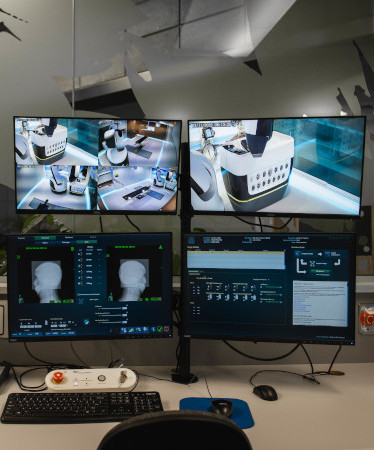Major study delivers positive news for Kiwi prostate cancer patients
Tue Oct. 29th 2024
Receiving a prostate cancer diagnosis is tough, for everyone. It can create anxiety and feel overwhelming. Many of those receiving a cancer diagnosis, along with their families and loved ones, will embark on an information gathering exercise to understand as much as possible about their disease, and equip themselves with the knowledge to actively participate in treatment decisions. With ongoing technological and medical improvements helping diagnose, treat and manage cancer for patients, staying informed is key.
Peter Dickens, Prostate Cancer Foundation CE, advises “We would urge all those affected by a prostate cancer diagnosis to explore all of the treatment options open to them so that they, in conjunction with their healthcare teams, can ensure they choose the treatment that will result in the best outcomes for them.”
Understanding Treatment Options
One decision patients with early-stage prostate cancer can make, in conjunction with their specialist, is the choice between a prostatectomy – the surgical removal of the prostate gland, or radiation therapy. Surgery has been the mainstay of treatment, but with the recent publication of data from a major international trial, there is now compelling new evidence for radiation therapy for men with early-stage prostate cancer.
The PACE-A study was carried out in 12 leading UK cancer centres. It found men with early-stage, localised disease who were treated with a five-dose course of Stereotactic Body Radiation Therapy (SBRT) experienced notably less downstream problems from the two side effects which concern them the most - urinary incontinence and sexual dysfunction - compared to men who underwent a robotic prostatectomy. The study found a slight increased risk of a third side effect - bowel bother - from SBRT.
Auckland Radiation Oncologist, Associate Professor Giuseppe Sasso, who has extensive experience treating patients with CyberKnife, a robotic system that delivers SBRT, is encouraged by the results.
“As a clinician, being able to sit down with a patient and tell him that SBRT will highly likely eradicate his disease effectively in five treatments and also reduce his chances of incontinence and impotence, is extremely positive,” he says. “It’s very important that men diagnosed with early-stage, localised disease are informed about the option of SBRT, to see if it might be suitable for them.”
What is Stereotactic Body Radiation Therapy (SBRT)?
SBRT is a highly precise form of radiation therapy used to treat cancer. It uses state of the art equipment to deliver a high dose of radiation to a tumor, while minimising damage to surrounding healthy tissue. While conventional radiation therapy might require many weeks of treatment, SBRT is usually completed in 5 sessions of around 30 min duration. SBRT is considered non-invasive, so patients can typically return to normal activities quickly. SBRT is available in several cancer centres across Aotearoa, delivered either by a conventional linear accelerator or by a dedicated robotic stereotactic radiotherapy unit.
CyberKnife - SBRT delivered by a robotic arm
CyberKnife is technology at its best! It uses a lightweight, fully mobile robotic device to deliver radiation treatment with exceptional accuracy. Tiny gold/titanium markers (called fiducials), are inserted inside the prostate gland by the patient’s urologist, and these enable the CyberKnife robot to continually track the prostate during treatment, adjusting the delivery of radiation beams to accurately target the cancer from hundreds of different directions.
“One problem we’ve always experienced radiating the prostate is the fact the prostate gland isn’t set in concrete - it moves when a patient breathes and when bladder or bowel volumes change,” says Auckland Radiation Oncology (ARO), Auckland City and Starship Hospital Radiation Oncologist, Dr Ramesh Pandey
He says CyberKnife solves this problem, detecting the patient’s slightest movement via the fiducials, adjusting the beams to immediately redirect treatment where needed. When compared with conventional linear accelerators, CyberKnife treats the prostate gland using better beam angles, reducing radiation dosage to the surrounding organs.
The accuracy of CyberKnife allows it to deliver high-doses of radiation with fewer side effects, allowing patients to carry on with their normal routines between treatments. "Patients often tell me they’ve had no side effects at all following their treatment,” Dr Pandey says.
Treatment Decisions are Unique to Every Patient
For decades New Zealand men have been offered both prostatectomy and conventional radiotherapy to treat prostate cancer – sometimes both. Standard radiotherapy requires up to 20 treatments over a 4-week course.
However, Kiwi patients can now access the world’s most advanced form of SBRT treatment, providing exceptional levels of precision and accuracy whilst also reducing their overall treatment duration to just 5 treatment appointments in total.
Dr Pandey believes treatment should be a shared decision-making process. “Every patient’s prostate cancer and individual circumstances are unique,” Dr Pandey says. “SBRT may be the best option for some men while surgery may still suit others, but men certainly need to explore all their options.”
If you, or someone you love, has received a prostate cancer diagnosis, it’s important to discuss treatment options with your lead healthcare professional. You can learn more about CyberKnife, or download an information brochure to support a discussion with your GP or medical specialist.

Understanding Your Treatment
The Patient Pathway
We understand you may be anxious about having radiation therapy. Read about the patient pathway and what to expect before, during and after radiation therapy treatment. At ARO we work closely with your radiation oncologist to develop an individualised treatment plan for each patient.
Explore the patient pathway





